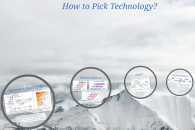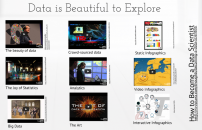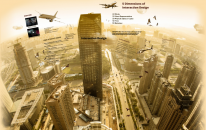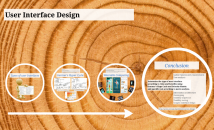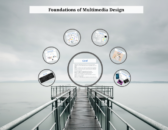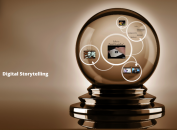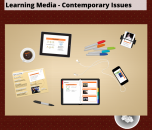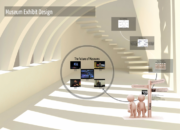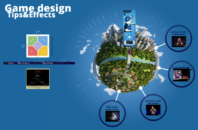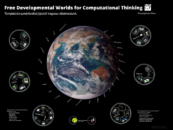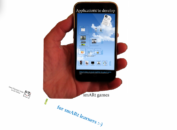Chapters
Scope
Definitions
Information is often composed in form of narratives/stories. Storytelling is the conveying of events in words, and images, often by improvisation or embellishment and is a means for sharing and interpreting experiences. A narrative (or story) is any account of connected events, presented to a reader or listener in a sequence of written or spoken words, or in a sequence of (moving) pictures.
Digital storytelling refers to a short form of digital media production that allows everyday people to share aspects of their life story. “Media” may include the digital equivalent of film techniques (full-motion video with sound), animation, stills, audio only, or any of the other forms of non-physical media (material that exists only as electronic files as opposed to actual paintings or photographs on paper, sounds stored on tape or disc, movies stored on film) which individuals can use to tell a story or present an idea.
The term “digital storytelling” can also cover a range of digital narratives (web-based stories, interactive stories, hypertexts, and narrative computer games); It is sometimes used to refer to film-making in general, and as of late, it has been used to describe advertising and promotion efforts by commercial and non-profit enterprises.
It is mainly used in education (pdf) in a broad sense, journalism, business, health and social services, entertainment and museums.
A podcast is a type of digital media consisting of an episodic series of audio radio, video, PDF, or ePub files subscribed to and downloaded through web syndication or streamed online to a computer or mobile device. The word is a neologism derived from “broadcast” and “pod” from the success of the iPod, as audio podcasts are often listened to on portable media players.
Interactive Storytelling [IS] is a form of digital entertainment in which users create or influence a dramatic storyline through actions, either by issuing commands to the story’s protagonist, or acting as a general director of events in the narrative. Interactive storytelling is a medium where the narrative, and its evolution, can be influenced in real-time by a user.[1]
Interactive Narrative Design combines ludology, narratology and game design to form interactive entertainment development methodologies.
Interactive Narrative Design focuses on creating meaningful participatory story experiences with interactive systems. The aim is to transport the player through play into the videogame (dataspace) using their visual and auditory senses. When interactive narrative design is successful, the VUP (viewer/user/player) believes that they are experiencing a story
Narrative is found in all forms of human creativity and art, including speech, writing, songs, film, television, video games, photography, theatre, and visual arts such as painting (with the modern art movements refusing the narrative in favour of the abstract and conceptual) that describes a sequence of events.
Narrative can be composed using several technologies and nowadays these technologies converge into Transmedia storytelling (also known as transmedia narrative or multiplatform storytelling) as the technique of telling a single story or story experience across multiple platforms and formats using current digital technologies. Transmedia storytelling is the embodiment of the constructivist approach to learning, incorporating all the hallmarks of social play structures. Sensorimotor (touching, moving, shaking, etc.), pretend play (acting out roles), Constructive (building, designing) and Games with rules (cognition changes from me to we) work together to create unique learning opportunities.
References: Definitions and links (unless otherwise indicated as “site” or “pdf”) are copied and edited from English Language Wikipedia as of 1st September 2013. Titles could be further explored through indicated links.
Research
Design issues
Mindmapping – VUE: in VUE directory
Case-studies
T@T lab case-studies:
- Kidlogo project (see Kidlogo.ppt)
- Triantafilou, S., Pixton, J., Kallenbach, K., Kalas, I., Turcsanyi-Szabo, M., Pintelas, P., Nikolova, I. (1997). MATCh: a Multimedia Authoring environmenT for Children (an INCO-Copernicus European Community Program), in Proceedings of the Sixth European Logo Conference, pp. 80-84. John von Neumann Computer Society, Budapest, Hungary – also published at http://comlogo.web.elte.hu/team/match/
- Turcsanyi-Szabo, M., Pluhar, Zs. (2003). Modular mind mapping, in Proceedings of Eurologo 2003, pp. 158-167, Porto, Portugal. – also published at http://matchsz.inf.elte.hu/Colabs/Porto/pubs/PZs_TSzM.pdf
(see PZs_TSzM.pdf)
- Turcsanyi-Szabo, M., Bedo, A., Pluhar, Zs. (2006). Case study of a TeaM Challenge game – e-PBL revisited, ed. Watson, D. Education and Information Technologies, No.4 October 2006. pp. 341-355, Springer http://www.springerlink.com/content/t4896677504820u2/ also
http://matchsz.inf.elte.hu/TSzM/Turcsanyi_EIT.pdf
- Turcsanyi-Szabo, M., Pluhár, Zs., Réthely-Prokkel, B., Kaszás, P., Abonyi-Tóth, A. (2003) “Colabs workshop”, Proceedings of Eurologo 2003, Porto, Portugal. – also published at http://matchsz.inf.elte.hu/Colabs/Porto/index.html
- Abonyi-Tóth A., Bodnár E., Turcsanyi-Szabo, M. (2005). “Telling you in pictures” – communication bridging languages, Proceedings of Eurologo 2005, pp. 307-312, 27-30 August, Warsaw, Poland. http://eurologo2005.oeiizk.waw.pl/PDF/E2005AbonyiEtAl.pdf
(see E2005AbonyiEtAl.pdf)
- Turcsányi-Szabó, M., Attila Paksi, (2007). Logo practice: from “turtling” to interactivity, pp?? (ed.) Kalas, I., EuroLogo 2007 – 40 Years of Influence on Education, Proceedings of the 11th European Logo Conference, Comenius University Bratislava, Slovakia. Also http://citeseerx.ist.psu.edu/viewdoc/summary?doi=10.1.1.97.1490
(see PP-Turcsanyi-Szabo.pdf)
- Turcsányi-Szabó, M., Pasaréti, O. (2010) The “computer“ tells a story? In Proc. of Constructionism 2010, pp. 26, Comenius University, Bratislava in association with The American University of Paris, Paris, ISBN: 978-80-89186-65-5 (print), ISBN 978-80-89186-66-2 (CD)
The Computer tells a Story http://matchsz.inf.elte.hu/VVprojekt/Pasareti_Turcsanyi.pdf
(see Pasareti_Turcsanyi.pdf)
Haricot beans Prezi
Demo video
video of presentation
E.G.

